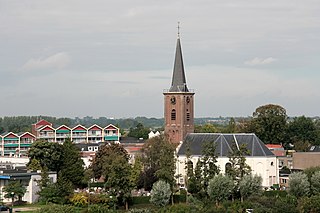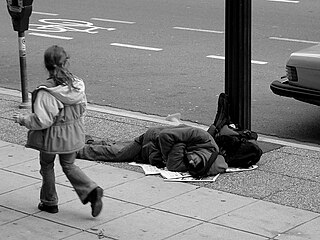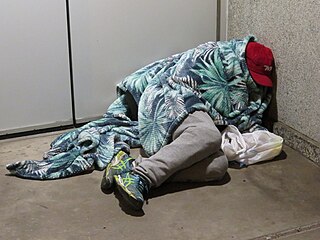
Demographic features of the population of the Netherlands include population density, ethnicity, education level, health of the population, economic status, religious affiliations and other aspects of the population.

The Enschede fireworks disaster was a catastrophic fireworks explosion on 13 May 2000 in Enschede, Netherlands. The explosion killed 23 people including four firefighters and injured 950 others. A total of 400 homes were destroyed and 1,500 buildings were subsequently damaged.

Homeless shelters are a type of service that provides temporary residence for homeless individuals and families. Shelters exist to provide residents with safety and protection from exposure to the weather while simultaneously reducing the environmental impact on the community. They are similar to, but distinguishable from, various types of emergency shelters, which are typically operated for specific circumstances and populations—fleeing natural disasters or abusive social circumstances. Extreme weather conditions create problems similar to disaster management scenarios, and are handled with warming centers, which typically operate for short durations during adverse weather.

Mijdrecht is a town in the Netherlands with about 16,000 residents. It is located in the municipality of De Ronde Venen, about 7 kilometres (4.3 mi) west of the main A2 motorway, between Utrecht and Amsterdam.

The Maritime Museum is a maritime museum in Amsterdam in the Netherlands.

In England, local authorities have duties to homeless people under Part VII of the Housing Act 1996 as amended by the Homelessness Act 2002. There are five hurdles which a homeless person must overcome in order to qualify as statutory homeless. If an applicant only meets the first three of these tests Councils still have a duty to provide interim accommodation. However an applicant must satisfy all five for a Council to have to give an applicant "reasonable preference" on the social housing register. Even if a person passes these five tests councils have the ability to use the private rented sector to end their duty to a homeless person.
Euthanasia in the Netherlands is regulated by the "Termination of Life on Request and Assisted Suicide Act" which was passed in 2001 and took effect in 2002. It states that euthanasia and physician-assisted suicide are not punishable if the attending physician acts in accordance with criteria of due care. These criteria concern the patient's request, the patient's suffering, the information provided to the patient, the absence of reasonable alternatives, consultation of another physician and the applied method of ending life. To demonstrate their compliance, the Act requires physicians to report euthanasia to a review committee.

Homelessness, also known as houselessness or being unhoused or unsheltered, is the condition of lacking stable, safe, and functional housing. It includes living on the streets, moving between temporary accommodation with family or friends, living in boarding houses with no security of tenure, and people who leave their homes because of civil conflict and are refugees within their country.

Anti-homelessness legislation can take two forms: legislation that aims to help and re-house homeless people; and legislation that is intended to send homeless people to homeless shelters compulsorily, or to criminalize homelessness and begging.
Indians in the Netherlands are residents of Indian origin in the Netherlands. The majority of the people of Indian descent in the Netherlands are of Indo-Surinamese origin. More recently the flow of emigrants from India has increased.

The adoption of plug-in electric vehicles in the Netherlands is actively supported by the Dutch government through the exemption of the registration fee and road taxes. These purchase incentives have been adjusted over time. Considering the potential of plug-in electric vehicles in the country due to its relative small size and geography, the Dutch government set a target of 15,000 to 20,000 electric vehicles with three or more wheels on the roads in 2015; 200,000 vehicles in 2020; and 1 million vehicles in 2025. The first two targets were achieved two years earlier than planned.

The San Francisco Bay Area comprises nine northern California counties and contains five of the ten most expensive counties in the United States. Strong economic growth has created hundreds of thousands of new jobs, but coupled with severe restrictions on building new housing units, it has resulted in a statewide housing shortage which has driven rents to extremely high levels. The Sacramento Bee notes that large cities like San Francisco and Los Angeles both attribute their recent increases in homeless people to the housing shortage, with the result that homelessness in California overall has increased by 15% from 2015 to 2017. In September 2019, the Council of Economic Advisers released a report in which they stated that deregulation of the housing markets would reduce homelessness in some of the most constrained markets by estimates of 54% in San Francisco, 40 percent in Los Angeles, and 38 percent in San Diego, because rents would fall by 55 percent, 41 percent, and 39 percent respectively. In San Francisco, a minimum wage worker would have to work approximately 4.7 full-time jobs to be able to spend less than 30% of their income on renting a two-bedroom apartment.

According to the United States Interagency Council on Homelessness, as of January 2017, there are an estimated 32,190 homeless individuals in Florida. Of this high number, 2,846 are family households, 2,019 are unaccompanied young adults, 2,817 are veterans, and an estimated 5,615 are individuals experiencing chronic homelessness. According to a January 2020 count, this figure was 27,487 on any given day, a decrease from previous years. According to the U.S. Department of Housing and Urban Development, as of December 2022, the estimate for homeless individuals has dropped to 25,959, about 5% of the total U.S. population. This is in spite of fears that moratorium's on evictions ending could lead to an increase in the homeless population.

Homelessness in the United States has differing rates of prevalence by state. The total number of homeless people in the United States fluctuates and constantly changes, hence a comprehensive figure encompassing the entire nation is not issued, since counts from independent shelter providers and statistics managed by the United States Department of Housing and Urban Development vary greatly. Federal HUD counts hover annually at around 500,000 people. Point-in-time counts are also vague measures of homeless populations and are not a precise and definitive indicator for the total number of cases, which may differ in both directions up or down. The most recent figure for 2019, was 567,715 individuals nationally that experienced homelessness at a point in time during this period.

Homelessness is a growing problem in Colorado and is considered the most important social determinants of health. Homelessness is very difficult for many Coloradoans to escape due to the continuous increase in costs for housing in Colorado, along with mental health treatments and other factors. When people are forced to live without stable shelter, they are then exposed to a number of risk factors that affect physical and mental health. Although it is difficult to pin point any one cause of homelessness, there is a complicated combination of societal and individual causes.

The United States Department of Housing and Urban Development estimated that more than 181,399 people were experiencing homelessness in California in January 2023. This is one of the highest per capita rates in the nation, with 0.46% of residents estimated as being homeless. More than two-thirds of homeless people in California are unsheltered, which is the highest percentage of any state in the United States. 49% of the unsheltered homeless people in the United States live in California. Even those who are sheltered are so insecurely, with 90% of homeless adults in California reporting that they spent at least one night unsheltered in the past six months.

Fireworks in the Netherlands are mostly regulated by the Vuurwerkbesluit, a 1993 law that has subsequently been amended many times to make the rules surrounding the production, testing, transportation, storage, trade, sale, consumption and overall safety of fireworks stricter.

Homelessness is a serious issue throughout the state of New Mexico. Through a demographic examination it becomes evident that New Mexico has a high proportion of ethnographies that are currently and historically socioeconomically disadvantaged. Native Americans as a proportion of the US population represent the second highest amongst all States with only Alaska having a higher ratio, while it also has a large Hispanic population. Homelessness is a direct cause from an individual not being able to provide themselves with the most basic of necessities to maintain a healthy life hence having a higher proportion of individuals in poverty places a greater risk of an individual becoming homeless.

Martin v. Boise was a 2018 decision by the U.S. Court of Appeals for the Ninth Circuit in response to a 2009 lawsuit by six homeless plaintiffs against the city of Boise, Idaho regarding the city's anti-camping ordinance. The ruling held that cities cannot enforce anti-camping ordinances if they do not have enough homeless shelter beds available for their homeless population. It did not necessarily mean a city cannot enforce any restrictions on camping on public property.
The population of the Netherlands is getting increasingly older, due to longer life expectancy and a sub-replacement fertility rate. In Dutch this phenomenon is called Vergrijzing. As of 1 January 2023 around 20% of the Dutch population is aged 65 or older. It is predicted that this will increase to 24% in 2035 with some areas facing more severe ageing than others, especially rural municipalities in the east of the country. It is expected that the following decades this percentage will continue to increase.
















